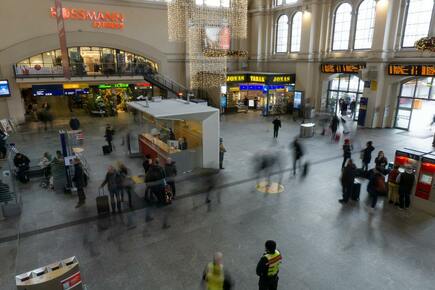What is piggy backing?
Piggybacking refers to one or more people following another person who has been authorized into a restricted or secure area. Typically, the first person gains authorization through an access control system ID card, biometric fingerprint / hand print, or similar device. Once the door has been opened any number of people can pass through the door unless preventative measures have been taken such as having guards on duty or an automated system that can detect and prevent unauthorized access through "piggybacking/tailgating".
Is tailgating the same as piggy backing?
The difference between the two terms is that piggybacking implies that the person who has opened the door with their credentials knows that others are following them in through the secure door. Tailgating means that others are following through the door without the knowledge of the person who has opened the door.
What is a mantrap?
A mantrap is a secured space equipped with two or more interlocking doors and a single person detection system to insure that only one person can pass through into a high security area such as a data center or research lab. The physical size of a mantrap area can be as small as 5' x 5' and may be considerably larger.
How do mantraps work?
Upon entering mantrap, T-DAR® three-dimensional stereo vision system scans area from above for confirmation of one person only. If more than one person is detected alarm is sounded and access is denied. Identification such as reader card or a biometric device must be presented to open 1 or more mantrap doors. The mantrap communicates with the access control system for inputs and outputs from doors.
What are interlocking doors?
Interlocking doors allow only one door at any time to be open. When any one door is open, all other doors of the mantrap system are automatically locked.
What happens when the mantrap alarm is activated?
How long does it take for each person to navigate through a mantrap system?
Assuming the mantrap is in the range of 8' to 10' long, total time to process one person is approximately nine to 10 seconds.
How long does it take for employees to get acclimated to the new system?
After one or two weeks all employees should be accustomed to the system.
Are carts allowed through the system?
Yes. Carts are easily distinguished from humans by the three-dimensional stereo vision T-DAR system.
How is the T-DAR system installed?
Newton Security provides thorough documentation including manuals, installation procedures and a checklist for your installer. After the system has been installed, if desired, we will come to your site (for a fee) to confirm system has been installed properly, commission and train your employees.
What kind of return on investment can we expect?
If you are currently using 24-hour guard service, a T-DAR mantrap system will pay for itself in a matter of months.
Are alternative "anti-tailgating" systems, suchas "break beam" systems effective?
Break-beam systems require visual separation between people to function. They cannot differentiate between a large person and two people hugging or "piggybacking". While they are one of the least expensive "anti-tailgating" systems available they are also relatively ineffective.
What about video analytics?
Just like break-beam systems, video analytics also require visual separation between people to function. Video analytics will usually catch innocent intruders, but will not stop a serious intruder that understands how to beat the system.
Piggybacking refers to one or more people following another person who has been authorized into a restricted or secure area. Typically, the first person gains authorization through an access control system ID card, biometric fingerprint / hand print, or similar device. Once the door has been opened any number of people can pass through the door unless preventative measures have been taken such as having guards on duty or an automated system that can detect and prevent unauthorized access through "piggybacking/tailgating".
Is tailgating the same as piggy backing?
The difference between the two terms is that piggybacking implies that the person who has opened the door with their credentials knows that others are following them in through the secure door. Tailgating means that others are following through the door without the knowledge of the person who has opened the door.
What is a mantrap?
A mantrap is a secured space equipped with two or more interlocking doors and a single person detection system to insure that only one person can pass through into a high security area such as a data center or research lab. The physical size of a mantrap area can be as small as 5' x 5' and may be considerably larger.
How do mantraps work?
Upon entering mantrap, T-DAR® three-dimensional stereo vision system scans area from above for confirmation of one person only. If more than one person is detected alarm is sounded and access is denied. Identification such as reader card or a biometric device must be presented to open 1 or more mantrap doors. The mantrap communicates with the access control system for inputs and outputs from doors.
What are interlocking doors?
Interlocking doors allow only one door at any time to be open. When any one door is open, all other doors of the mantrap system are automatically locked.
What happens when the mantrap alarm is activated?
- All doors on the secure side of man trap will remained locked. Access will not be granted to a card holder or through a biometric read, etc. until the mantrap has been cleared.
- An adjustable volume audible alarm warning message is played along with a flashing light, both typically located in the mantrap.
- The mantrap must be cleared before proceeding with further attempts to access the secure facility.
- Security personnel will receive notification of the alarm and can determine if further action is required, dispatch guards, reprimand employees, etc.
- Video from the T-DAR system and the access control system may be viewed by security personnel to gather the facts of who was in mantrap at time of alarm, where they are now, and where they have been in facility.
How long does it take for each person to navigate through a mantrap system?
Assuming the mantrap is in the range of 8' to 10' long, total time to process one person is approximately nine to 10 seconds.
How long does it take for employees to get acclimated to the new system?
After one or two weeks all employees should be accustomed to the system.
Are carts allowed through the system?
Yes. Carts are easily distinguished from humans by the three-dimensional stereo vision T-DAR system.
How is the T-DAR system installed?
Newton Security provides thorough documentation including manuals, installation procedures and a checklist for your installer. After the system has been installed, if desired, we will come to your site (for a fee) to confirm system has been installed properly, commission and train your employees.
What kind of return on investment can we expect?
If you are currently using 24-hour guard service, a T-DAR mantrap system will pay for itself in a matter of months.
Are alternative "anti-tailgating" systems, suchas "break beam" systems effective?
Break-beam systems require visual separation between people to function. They cannot differentiate between a large person and two people hugging or "piggybacking". While they are one of the least expensive "anti-tailgating" systems available they are also relatively ineffective.
What about video analytics?
Just like break-beam systems, video analytics also require visual separation between people to function. Video analytics will usually catch innocent intruders, but will not stop a serious intruder that understands how to beat the system.




